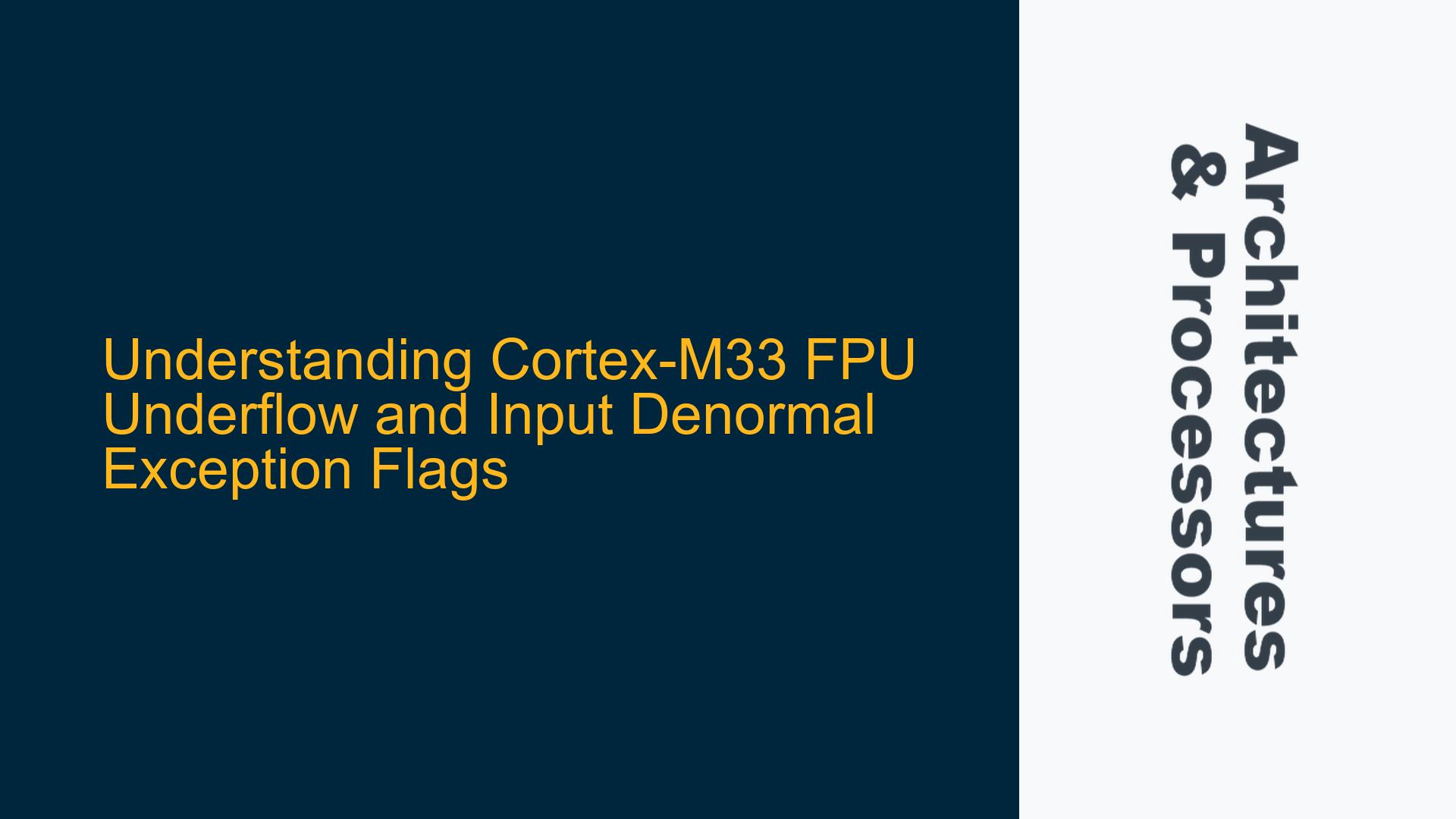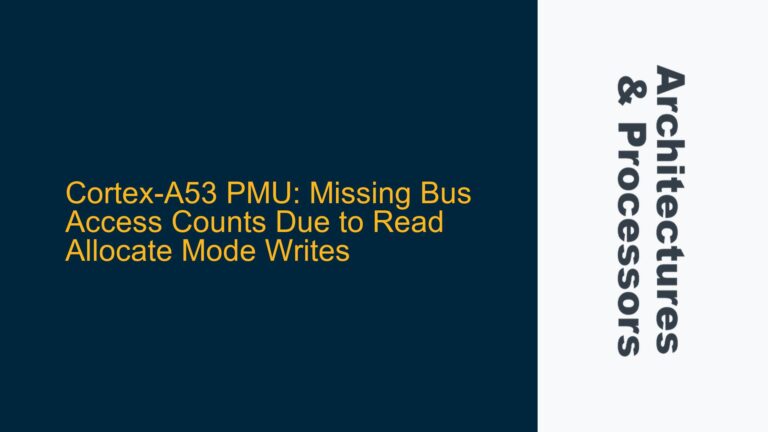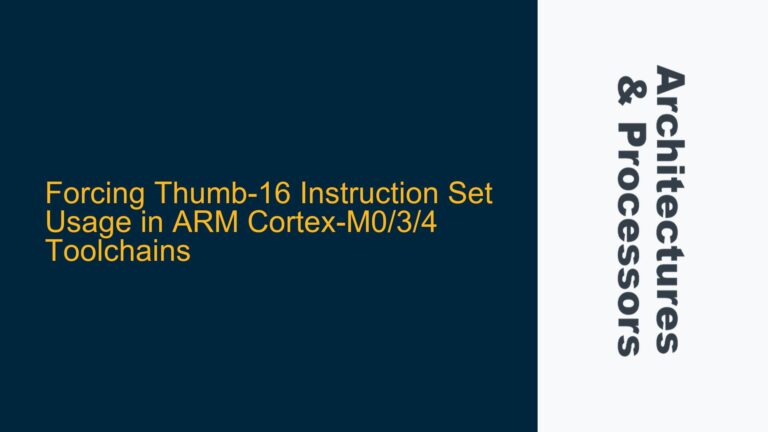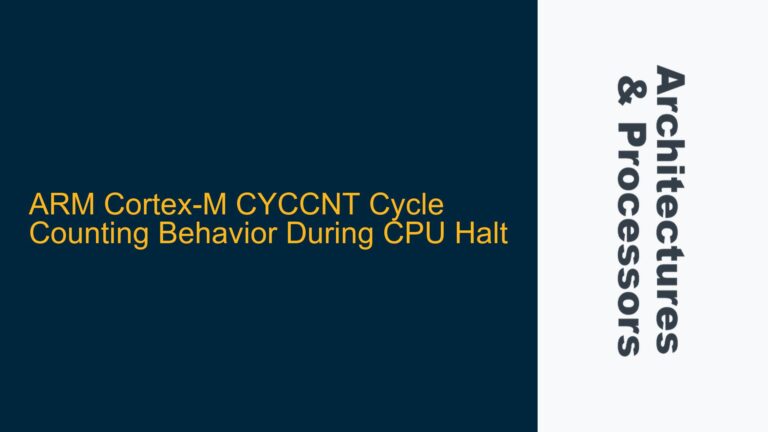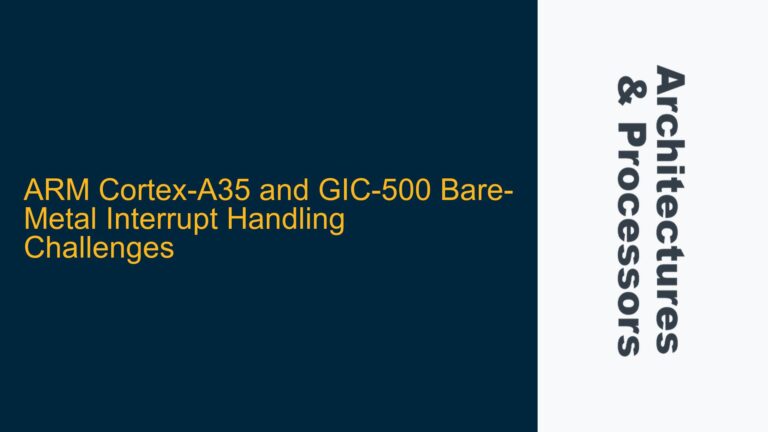Cortex-M33 FPU Underflow and Input Denormal Exception Flag Conditions
The Cortex-M33 Floating Point Unit (FPU) is a critical component for handling floating-point arithmetic in embedded systems. It provides hardware support for single-precision floating-point operations, which are essential for applications requiring high precision and performance. However, the FPU can generate specific exception flags under certain conditions, such as underflow and input denormal exceptions. These flags are part of the FPU’s status and control register, and understanding their triggering conditions is crucial for robust software design.
Underflow and input denormal exceptions are particularly important because they indicate situations where the precision of floating-point calculations may be compromised. Underflow occurs when a calculation produces a result that is too small to be represented accurately within the FPU’s range. Input denormal exceptions, on the other hand, occur when the FPU encounters a denormal number, which is a number that is smaller than the smallest normal number that can be represented in the FPU’s format. Both conditions can lead to significant errors in calculations if not handled properly.
The Cortex-M33 FPU follows the IEEE 754 standard for floating-point arithmetic, which defines the behavior of floating-point operations and the conditions under which exceptions should be raised. The FPU’s exception flags are set according to this standard, and understanding the specific conditions that trigger these flags is essential for writing reliable and efficient software.
Conditions Triggering Underflow and Input Denormal Flags
Underflow and input denormal exceptions in the Cortex-M33 FPU are triggered by specific conditions related to the representation and manipulation of floating-point numbers. These conditions are defined by the IEEE 754 standard and are implemented in the FPU’s hardware logic.
Underflow occurs when the result of a floating-point operation is smaller than the smallest normal number that can be represented in the FPU’s format. In single-precision floating-point format, the smallest normal number is approximately 1.18 × 10^-38. When a calculation produces a result that is smaller than this value, the FPU sets the underflow flag. This condition can occur during multiplication, division, or subtraction operations, where the operands are very small or the result of the operation is very small.
Input denormal exceptions occur when the FPU encounters a denormal number as an input to a floating-point operation. Denormal numbers are numbers that are smaller than the smallest normal number but larger than zero. They are represented with a biased exponent of zero and a non-zero significand. When the FPU encounters a denormal number, it sets the input denormal flag. This condition can occur when reading data from memory or when receiving data from another source that contains denormal numbers.
The FPU’s behavior when encountering underflow or input denormal conditions depends on the configuration of the FPU’s control register. The control register contains bits that enable or disable specific exceptions, including underflow and input denormal exceptions. If these exceptions are enabled, the FPU will set the corresponding flags and may also generate an exception interrupt, depending on the configuration. If the exceptions are disabled, the FPU will handle the conditions silently, possibly with a loss of precision.
Handling Underflow and Input Denormal Conditions in Software
Handling underflow and input denormal conditions in software requires a thorough understanding of the FPU’s behavior and the specific conditions that trigger these exceptions. The first step in handling these conditions is to ensure that the FPU’s control register is configured correctly. This involves enabling or disabling the underflow and input denormal exceptions based on the requirements of the application.
If underflow and input denormal exceptions are enabled, the software must include exception handlers to manage these conditions. The exception handlers should check the FPU’s status register to determine which exception occurred and take appropriate action. For underflow conditions, the software may choose to scale the operands or the result to avoid loss of precision. For input denormal conditions, the software may choose to normalize the input data before performing the operation.
In some cases, it may be necessary to handle underflow and input denormal conditions without generating an exception interrupt. This can be achieved by configuring the FPU to handle these conditions silently and checking the FPU’s status register periodically to detect any exceptions that may have occurred. The software can then take appropriate action based on the status of the exception flags.
Another important consideration when handling underflow and input denormal conditions is the impact on performance. Enabling exceptions and handling them in software can introduce additional overhead, which may be unacceptable in performance-critical applications. In such cases, it may be necessary to disable these exceptions and accept a potential loss of precision. However, this approach should be used with caution, as it can lead to significant errors in calculations.
In summary, handling underflow and input denormal conditions in the Cortex-M33 FPU requires careful configuration of the FPU’s control register and the implementation of appropriate exception handlers in software. By understanding the conditions that trigger these exceptions and the impact on performance, developers can ensure that their software handles floating-point arithmetic reliably and efficiently.
Detailed Analysis of Underflow and Input Denormal Conditions
To provide a more detailed analysis of underflow and input denormal conditions in the Cortex-M33 FPU, it is necessary to examine the specific conditions that trigger these exceptions and the impact on floating-point calculations. This analysis will focus on the IEEE 754 standard and its implementation in the Cortex-M33 FPU.
Underflow occurs when the result of a floating-point operation is smaller than the smallest normal number that can be represented in the FPU’s format. In single-precision floating-point format, the smallest normal number is approximately 1.18 × 10^-38. When a calculation produces a result that is smaller than this value, the FPU sets the underflow flag. This condition can occur during multiplication, division, or subtraction operations, where the operands are very small or the result of the operation is very small.
For example, consider the multiplication of two very small numbers, such as 1.0 × 10^-39 and 1.0 × 10^-39. The result of this operation is 1.0 × 10^-78, which is smaller than the smallest normal number that can be represented in single-precision floating-point format. In this case, the FPU will set the underflow flag to indicate that the result is too small to be represented accurately.
Input denormal exceptions occur when the FPU encounters a denormal number as an input to a floating-point operation. Denormal numbers are numbers that are smaller than the smallest normal number but larger than zero. They are represented with a biased exponent of zero and a non-zero significand. When the FPU encounters a denormal number, it sets the input denormal flag. This condition can occur when reading data from memory or when receiving data from another source that contains denormal numbers.
For example, consider the addition of two numbers, where one of the numbers is a denormal number, such as 1.0 × 10^-45. When the FPU encounters this number, it will set the input denormal flag to indicate that the input is a denormal number. The FPU will then handle the denormal number according to the IEEE 754 standard, which may involve normalizing the number before performing the operation.
The impact of underflow and input denormal conditions on floating-point calculations can be significant. Underflow can lead to a loss of precision, as the result of the operation may be rounded to zero or the smallest representable number. Input denormal conditions can also lead to a loss of precision, as the FPU may need to normalize the input data before performing the operation. In both cases, the loss of precision can lead to errors in calculations, which may be unacceptable in some applications.
To mitigate the impact of underflow and input denormal conditions, it is important to understand the specific conditions that trigger these exceptions and to implement appropriate handling mechanisms in software. This may involve scaling the operands or the result to avoid underflow, normalizing input data to avoid input denormal conditions, or configuring the FPU to handle these conditions silently.
Practical Considerations for Handling Underflow and Input Denormal Conditions
In practice, handling underflow and input denormal conditions in the Cortex-M33 FPU requires careful consideration of the specific requirements of the application and the impact on performance. This section will discuss some practical considerations for handling these conditions, including the configuration of the FPU’s control register, the implementation of exception handlers, and the impact on performance.
The first consideration when handling underflow and input denormal conditions is the configuration of the FPU’s control register. The control register contains bits that enable or disable specific exceptions, including underflow and input denormal exceptions. If these exceptions are enabled, the FPU will set the corresponding flags and may also generate an exception interrupt, depending on the configuration. If the exceptions are disabled, the FPU will handle the conditions silently, possibly with a loss of precision.
The decision to enable or disable underflow and input denormal exceptions depends on the requirements of the application. In applications where precision is critical, such as scientific computing or financial calculations, it may be necessary to enable these exceptions and handle them in software. In applications where performance is critical, such as real-time signal processing or control systems, it may be necessary to disable these exceptions and accept a potential loss of precision.
If underflow and input denormal exceptions are enabled, the software must include exception handlers to manage these conditions. The exception handlers should check the FPU’s status register to determine which exception occurred and take appropriate action. For underflow conditions, the software may choose to scale the operands or the result to avoid loss of precision. For input denormal conditions, the software may choose to normalize the input data before performing the operation.
In some cases, it may be necessary to handle underflow and input denormal conditions without generating an exception interrupt. This can be achieved by configuring the FPU to handle these conditions silently and checking the FPU’s status register periodically to detect any exceptions that may have occurred. The software can then take appropriate action based on the status of the exception flags.
Another important consideration when handling underflow and input denormal conditions is the impact on performance. Enabling exceptions and handling them in software can introduce additional overhead, which may be unacceptable in performance-critical applications. In such cases, it may be necessary to disable these exceptions and accept a potential loss of precision. However, this approach should be used with caution, as it can lead to significant errors in calculations.
In summary, handling underflow and input denormal conditions in the Cortex-M33 FPU requires careful configuration of the FPU’s control register and the implementation of appropriate exception handlers in software. By understanding the conditions that trigger these exceptions and the impact on performance, developers can ensure that their software handles floating-point arithmetic reliably and efficiently.
Conclusion
The Cortex-M33 FPU’s underflow and input denormal exception flags are critical for ensuring the accuracy and reliability of floating-point calculations in embedded systems. Understanding the conditions that trigger these flags and implementing appropriate handling mechanisms in software is essential for robust system design. By carefully configuring the FPU’s control register, implementing exception handlers, and considering the impact on performance, developers can ensure that their software handles floating-point arithmetic reliably and efficiently.
In conclusion, the Cortex-M33 FPU’s underflow
